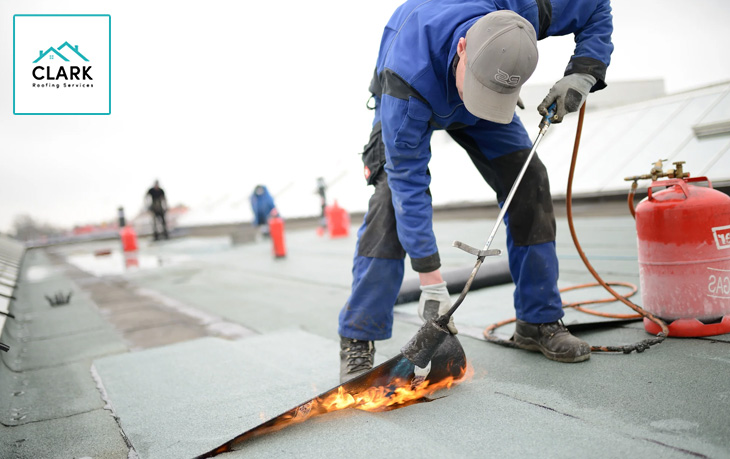Flat Roof Repair
Flat roof repair is an important service for buildings in Carson with flat roofing systems. Over time, flat roofs can develop leaks due to weathering, movement, improper installation, and other factors. Top notch roofing contractors like Clark Roofing Services inspect flat roofs to find problem areas and make necessary repairs to stop leaks. Proper Carson flat roof repair helps maintain roof integrity, prevent water damage to buildings, and extend the lifespan of flat roof systems in Carson.
Our experienced team specializes in flat roof repair, providing prompt and reliable solutions to protect your property from water damage and other issues. With our expertise and high-quality materials, we ensure long-lasting results for your flat roof. Don’t let a damaged flat roof compromise your building’s integrity – contact Clark Roofing Services for expert Carson flat roof repair today.

Common Flat Roof Problems
Flat roofs are prone to various issues due to their unique design and exposure to the elements. Identifying and addressing these problems promptly is crucial to avoid costly water damage and maintain your roof’s integrity. Here are some common flat roof problems:
Ponding Water
Ponding water occurs when water accumulates on your flat roof and fails to drain properly. This issue can lead to several problems:
- Increased weight on the roof structure
- Accelerated deterioration of roofing materials
- Potential for leaks and water infiltration
Leaks and Cracks
Leaks and cracks in your flat roof can allow water to penetrate the building, causing damage to the interior. These issues may arise due to:
- Aging or poor-quality roofing materials
- Improper installation or flashing
- Damage from debris or foot traffic
Blistering and Bubbling
Blistering and bubbling on your flat roof’s surface indicate trapped moisture or air beneath the membrane. This problem can be caused by:
- Inadequate ventilation
- Improper installation
- Exposure to high temperatures
Damaged Flashing
Flashing is the material used to seal the edges and penetrations of your flat roof. When flashing is damaged, it can allow water to seep into the building. Common causes of flashing damage include:
- Improper installation
- Weathering and aging
- Physical damage from debris or foot traffic
Identifying Flat Roof Leaks
Flat roof leaks can be challenging to locate, as water may travel some distance from the original entry point before becoming visible inside the building. Contact us for prompt identification and repair of leaks are essential to minimize water damage and prevent further deterioration of your roof.
| Signs of a Flat Roof Leak | Investigation Methods |
| Water stains on ceilings or walls | Visual inspection of the roof surface |
| Mold or mildew growth | Infrared thermography to detect moisture |
| Sagging or soft spots on the roof | Water testing to pinpoint leak sources |
| Visible cracks or gaps in the roofing material | Checking flashing and seals around penetrations |
Our Flat Roof Repair Process
At Clark Roofing Services, we follow a systematic approach to ensure effective and long-lasting flat roof repairs. Our process includes:
Inspection and Assessment
Our team thoroughly inspects your flat roof to identify the extent and cause of the damage. We assess:
- The overall condition of the roofing material
- The severity of leaks or other issues
- The need for localized repairs or full roof replacement
Surface Preparation
Before beginning repairs, we prepare the roof surface to ensure optimal results. This step involves:
- Cleaning the area to remove dirt, debris, and loose material
- Drying the surface to ensure proper adhesion of repair materials
- Applying primer or other surface treatments as needed
Repair Techniques
Depending on the type and extent of damage, we employ various repair techniques, such as:
- Patching holes, cracks, or blisters with appropriate materials
- Replacing damaged flashing or sealants
- Reinforcing weak or compromised areas of the roof
Quality Control and Cleanup
After completing the repairs, we perform a final inspection to ensure the work meets our high standards. We then:
- Clean the work area and dispose of any debris
- Provide you with a detailed report of the repairs performed
- Offer maintenance recommendations to prolong your roof’s life

Flat Roof Repair in Different Climates
The approach to flat roof repair may vary depending on the local climate and weather conditions. Here’s how different climates can impact flat roof repair:
Hot and Dry Climates
In hot and dry climates, flat roofs are exposed to intense sunlight and high temperatures, which can cause the roofing material to deteriorate more quickly.
- Use reflective coatings to minimize heat absorption and protect the roof surface
- Ensure proper ventilation to prevent heat buildup and blistering
- Schedule repairs during cooler times of the day to avoid heat-related complications
Cold and Wet Climates
Cold and wet climates can expose flat roofs to snow, ice, and frequent rainfall, leading to unique challenges.
- Ensure proper insulation to prevent ice dams and condensation
- Use materials that can withstand freeze-thaw cycles and extreme temperature fluctuations
- Address drainage issues promptly to prevent ponding water and ice buildup
Coastal Climates
Flat roofs in coastal climates are subject to high humidity, salt air, and strong winds, which can accelerate deterioration and corrosion.
FAQs
- Minimizing water damage
- Preventing structural damage
- Avoiding energy loss
- Prolonging roof lifespan
- Maintaining a safe environment.
- Ice dams
- Freeze-thaw cycles
- Condensation
- Snow and ice weight:
- Limited repair windows



